Around the World
September/October 2020
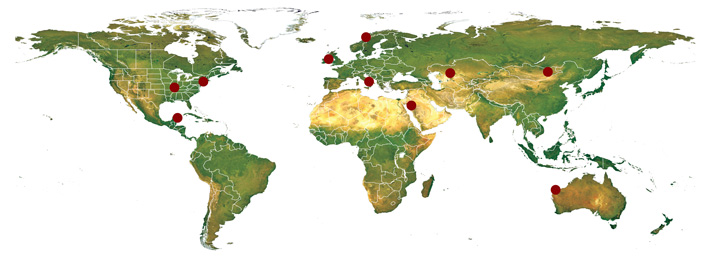

-
 ILLINOIS: The catalyst behind the pre-Columbian city of Cahokia’s rapid rise may have been the arrival of maize cultivation technology. Isotope analysis of human and dog teeth found there provided insight into the local diet, and dating of corn kernels from the Mississippi River site reveal that maize was abruptly introduced to the area between A.D. 950 and 1000. This development likely helped fuel Cahokia’s population explosion over the next century, at the end of which it had as many as 20,000 inhabitants, making it the largest settlement in North America.
ILLINOIS: The catalyst behind the pre-Columbian city of Cahokia’s rapid rise may have been the arrival of maize cultivation technology. Isotope analysis of human and dog teeth found there provided insight into the local diet, and dating of corn kernels from the Mississippi River site reveal that maize was abruptly introduced to the area between A.D. 950 and 1000. This development likely helped fuel Cahokia’s population explosion over the next century, at the end of which it had as many as 20,000 inhabitants, making it the largest settlement in North America. -
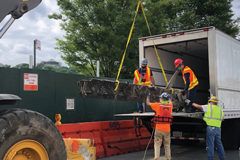 NEW YORK: New York City authorities have raised sections of a once-famous yet long-forgotten boat from the bottom of North Cove along the Harlem River. They believe the salvaged pieces belong to PT-59, which John F. Kennedy captained in World War II after his previous boat, PT-109, was rammed by a Japanese destroyer. In 1943, both Kennedy and PT-59 helped rescue several endangered Marines from Choiseul Island in the Solomon Islands. The boat was transferred to private ownership after the war and eventually sank in the 1970s.
NEW YORK: New York City authorities have raised sections of a once-famous yet long-forgotten boat from the bottom of North Cove along the Harlem River. They believe the salvaged pieces belong to PT-59, which John F. Kennedy captained in World War II after his previous boat, PT-109, was rammed by a Japanese destroyer. In 1943, both Kennedy and PT-59 helped rescue several endangered Marines from Choiseul Island in the Solomon Islands. The boat was transferred to private ownership after the war and eventually sank in the 1970s. -
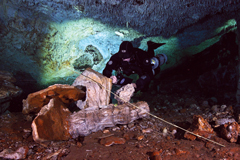 MEXICO: For nearly 2 decades, experts were puzzled by ancient human remains found in the now-submerged Sagitario cave system on the eastern Yucatan Peninsula. They now think these remains may belong to Paleolithic miners who exploited the oldest ochre mines found in the Americas. Underwater archaeologists located digging tools, navigational markers, and other signs of human activity dating back more than 10,000 years, indicating that Paleoindians ventured deep underground to extract the valuable red pigment.
MEXICO: For nearly 2 decades, experts were puzzled by ancient human remains found in the now-submerged Sagitario cave system on the eastern Yucatan Peninsula. They now think these remains may belong to Paleolithic miners who exploited the oldest ochre mines found in the Americas. Underwater archaeologists located digging tools, navigational markers, and other signs of human activity dating back more than 10,000 years, indicating that Paleoindians ventured deep underground to extract the valuable red pigment. -
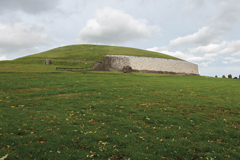 IRELAND: The enormous 5,500-year-old tomb of Newgrange in County Meath is one of Ireland’s best-known Neolithic monuments, yet many questions remain about the people responsible for its construction. New analysis of the DNA of one of those interred within the tomb indicates he was a product of incest, either between siblings or parent and child. This implies that Newgrange may have been built by a hereditary dynasty that broke social taboos, much like some Egyptian pharaohs, to keep power within the family.
IRELAND: The enormous 5,500-year-old tomb of Newgrange in County Meath is one of Ireland’s best-known Neolithic monuments, yet many questions remain about the people responsible for its construction. New analysis of the DNA of one of those interred within the tomb indicates he was a product of incest, either between siblings or parent and child. This implies that Newgrange may have been built by a hereditary dynasty that broke social taboos, much like some Egyptian pharaohs, to keep power within the family. -
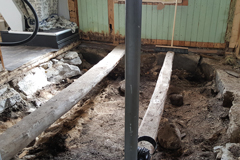 NORWAY: A very surprised Norwegian family encountered a Viking grave while renovating their house in Bodo. The building’s floorboards were removed, revealing a series of stones, an ax head, iron implements, and a shiny round object that appeared at first to be the wheel of a toy car. When archaeologists were summoned, they determined that the small artifact was actually a glass bead and that the items were all likely part of a Viking burial dating to the 9th century A.D.
NORWAY: A very surprised Norwegian family encountered a Viking grave while renovating their house in Bodo. The building’s floorboards were removed, revealing a series of stones, an ax head, iron implements, and a shiny round object that appeared at first to be the wheel of a toy car. When archaeologists were summoned, they determined that the small artifact was actually a glass bead and that the items were all likely part of a Viking burial dating to the 9th century A.D. -
 ITALY: A sinkhole that opened up near the Pantheon in Rome’s Piazza della Rotonda exposed a section of Roman paving dating back 2,000 years. Seven travertine stone slabs were revealed lying 8 feet below the modern cobblestone street surface. The slabs were part of the original Pantheon building project, carried out between 27 and 25 B.C. by the emperor Augustus’ right-hand man Marcus Agrippa. Only the facade of Agrippa’s temple remains visible today, as the structure was later rebuilt by the emperor Hadrian, who commissioned its famous dome.
ITALY: A sinkhole that opened up near the Pantheon in Rome’s Piazza della Rotonda exposed a section of Roman paving dating back 2,000 years. Seven travertine stone slabs were revealed lying 8 feet below the modern cobblestone street surface. The slabs were part of the original Pantheon building project, carried out between 27 and 25 B.C. by the emperor Augustus’ right-hand man Marcus Agrippa. Only the facade of Agrippa’s temple remains visible today, as the structure was later rebuilt by the emperor Hadrian, who commissioned its famous dome. -
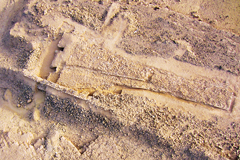 SAUDI ARABIA: Nomadic pastoralists roaming northern Saudi Arabia 7,500 years ago built an unusual stone platform near the oasis site of Dumat al-Jandal. The trapezoidal monument was first constructed in the middle of the 6th millennium B.C., but was modified several times, eventually reaching a length of 115 feet. In and around the structure, archaeologists discovered several burials that suggest the stone monument was an important place of commemoration that was used for funerary and social rituals for thousands of years.
SAUDI ARABIA: Nomadic pastoralists roaming northern Saudi Arabia 7,500 years ago built an unusual stone platform near the oasis site of Dumat al-Jandal. The trapezoidal monument was first constructed in the middle of the 6th millennium B.C., but was modified several times, eventually reaching a length of 115 feet. In and around the structure, archaeologists discovered several burials that suggest the stone monument was an important place of commemoration that was used for funerary and social rituals for thousands of years. -
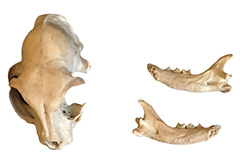 KAZAKHSTAN: The remains of a tomcat found in the ruins of Dzhankent represent the oldest known case of feline domestication along the Silk Road. The find dates to around the 8th century A.D., several hundred years before it was thought that local Oghuz tribes first kept cats as pets. Skeletal analysis shows that the animal suffered tooth loss as a result of a soft, protein-rich diet provided by its human owners. The feline had also suffered multiple injuries during its lifetime, limiting its chances for survival without human assistance.
KAZAKHSTAN: The remains of a tomcat found in the ruins of Dzhankent represent the oldest known case of feline domestication along the Silk Road. The find dates to around the 8th century A.D., several hundred years before it was thought that local Oghuz tribes first kept cats as pets. Skeletal analysis shows that the animal suffered tooth loss as a result of a soft, protein-rich diet provided by its human owners. The feline had also suffered multiple injuries during its lifetime, limiting its chances for survival without human assistance. -
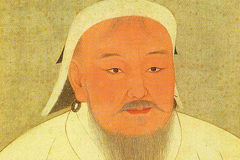 MONGOLIA: During his life, Genghis Khan was often on the move, launching invasions and conquering territory across Eurasia. In the 13th century, he founded the Mongol Empire, which eventually stretched from the Pacific Ocean to Eastern Europe. However, between campaigns, Genghis and his army would return to his winter camp, or ordu, whose location has been debated for decades. New research at the site of Avraga in eastern Mongolia now links it with the khan’s lifetime, suggesting it was likely the site of his off-season headquarters.
MONGOLIA: During his life, Genghis Khan was often on the move, launching invasions and conquering territory across Eurasia. In the 13th century, he founded the Mongol Empire, which eventually stretched from the Pacific Ocean to Eastern Europe. However, between campaigns, Genghis and his army would return to his winter camp, or ordu, whose location has been debated for decades. New research at the site of Avraga in eastern Mongolia now links it with the khan’s lifetime, suggesting it was likely the site of his off-season headquarters. -
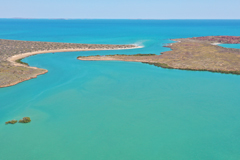 AUSTRALIA: When humans began to settle in Australia during the Last Glacial Period, 65,000 years ago, sea levels were at least 260 feet lower than they are today. Coastal sites occupied at that time were gradually flooded beneath rising waters. For the first time, scientists have identified 2 underwater Aboriginal sites within the Dampier Archipelago. One site that dates back at least 7,000 years yielded more than 250 stone tools lying along the seabed while the other showed signs of human presence near a now-submerged freshwater spring.
AUSTRALIA: When humans began to settle in Australia during the Last Glacial Period, 65,000 years ago, sea levels were at least 260 feet lower than they are today. Coastal sites occupied at that time were gradually flooded beneath rising waters. For the first time, scientists have identified 2 underwater Aboriginal sites within the Dampier Archipelago. One site that dates back at least 7,000 years yielded more than 250 stone tools lying along the seabed while the other showed signs of human presence near a now-submerged freshwater spring.
Advertisement
IN THIS ISSUE
Digs & Discoveries
Siberian Island Enigma
Off the Grid
Closing in on a Pharaoh's Tomb
A Rare Egg
Mouse in the House
Commander's Orders
The Means of Production
Yesterday, Today, and Tomorrow
Missing Mosaics
Stonehenge's New Neighbor
Dark Earth in the Amazon
Reindeer Training
Around the World
A president’s torpedo boat, Cahokia corn farmers, a Viking surprise, and Genghis Khan in winter
Artifact
Reeling in the years
Advertisement

Recent Issues
-
 May/June 2024
May/June 2024
-
 March/April 2024
March/April 2024
-
 January/February 2024
January/February 2024
-
 November/December 2023
November/December 2023
-
 September/October 2023
September/October 2023
-
 July/August 2023
July/August 2023
-
 May/June 2023
May/June 2023
-
 March/April 2023
March/April 2023
-
 January/February 2023
January/February 2023
-
 November/December 2022
November/December 2022
-
 September/October 2022
September/October 2022
-
 July/August 2022
July/August 2022
-
 May/June 2022
May/June 2022
-
 March/April 2022
March/April 2022
-
 January/February 2022
January/February 2022
-
 November/December 2021
November/December 2021
-
 September/October 2021
September/October 2021
-
 July/August 2021
July/August 2021
-
 May/June 2021
May/June 2021
-
 March/April 2021
March/April 2021
-
 January/February 2021
January/February 2021
-
 November/December 2020
November/December 2020
-
 September/October 2020
September/October 2020
-
 July/August 2020
July/August 2020
-
 May/June 2020
May/June 2020
-
 March/April 2020
March/April 2020
-
 January/February 2020
January/February 2020
-
 November/December 2019
November/December 2019
-
 September/October 2019
September/October 2019
-
 July/August 2019
July/August 2019
-
 May/June 2019
May/June 2019
-
 March/April 2019
March/April 2019
-
 January/February 2019
January/February 2019
-
 November/December 2018
November/December 2018
-
 September/October 2018
September/October 2018
-
 July/August 2018
July/August 2018
-
 May/June 2018
May/June 2018
-
 March/April 2018
March/April 2018
-
 January/February 2018
January/February 2018
-
 November/December 2017
November/December 2017
-
 September/October 2017
September/October 2017
-
 July/August 2017
July/August 2017
-
 May/June 2017
May/June 2017
-
 March/April 2017
March/April 2017
-
 January/February 2017
January/February 2017
-
 November/December 2016
November/December 2016
-
 September/October 2016
September/October 2016
-
 July/August 2016
July/August 2016
-
 May/June 2016
May/June 2016
-
 March/April 2016
March/April 2016
-
 January/February 2016
January/February 2016
-
 November/December 2015
November/December 2015
-
 September/October 2015
September/October 2015
-
 July/August 2015
July/August 2015
-
 May/June 2015
May/June 2015
-
 March/April 2015
March/April 2015
-
 January/February 2015
January/February 2015
-
 November/December 2014
November/December 2014
-
 September/October 2014
September/October 2014
-
 July/August 2014
July/August 2014
-
 May/June 2014
May/June 2014
-
 March/April 2014
March/April 2014
-
 January/February 2014
January/February 2014
-
 November/December 2013
November/December 2013
-
 September/October 2013
September/October 2013
-
 July/August 2013
July/August 2013
-
 May/June 2013
May/June 2013
-
 March/April 2013
March/April 2013
-
 January/February 2013
January/February 2013
-
 November/December 2012
November/December 2012
-
 Sep/Oct 2012
Sep/Oct 2012
-
 September/October 2012
September/October 2012
-
 July/August 2012
July/August 2012
-
 May/June 2012
May/June 2012
-
 March/April 2012
March/April 2012
-
 January/February 2012
January/February 2012
-
 November/December 2011
November/December 2011
-
 September/October 2011
September/October 2011
-
 July/August 2011
July/August 2011
-
 May/June 2011
May/June 2011
-
 March/April 2011
March/April 2011
-
 January/February 2011
January/February 2011
Advertisement






